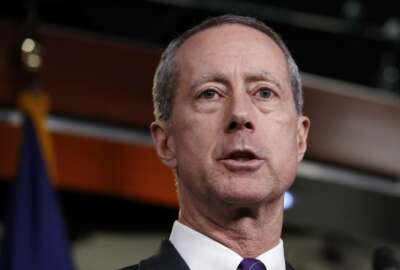
House NDAA leaves DISA mostly intact, but significantly curtails its missions
The House Armed Services Committee's version of the annual Defense bill lets DISA continue to operate, but it strips DISA's acquisition, cyber defense missions.
Capitol Hill’s opening salvo in this year’s process of drawing up a Defense authorization bill spared five agencies that had previously been on the House Armed Services Committee’s chopping block, but still includes provisions that could affect thousands of employees, particularly in metro areas around Washington, D.C. and St. Louis.
The committee’s version of the 2019 National Defense Authorization Act — forwarded to the House floor on Thursday after a marathon session of debate on dozens of policy issues and $700 billion in spending — would significantly pare back the mission of the Defense Information Systems Agency (DISA) and completely eliminate Washington Headquarters Services (WHS).
The legislation is a tamped-down version of the cuts the committee’s chairman, Rep. Mac Thornberry (R-Texas), first proposed several weeks ago, when he advocated for the wholesale elimination of seven Defense agencies that are outside of the three military departments — part of the Pentagon’s “fourth estate.”
The bill, which still must be approved by the full House and negotiated with the Senate, would leave DISA largely intact.
But it would mandate that key portions of its network defense mission — the ones conducted by Joint Force Headquarters-DoD Information Networks (JFHQ-DoDIN) — be transferred to U.S. Cyber Command by 2019.
Currently, DISA’s director is dual-hatted as the commander of the JFHQ, an organization that was first created just three years ago at the suggestion of CYBERCOM’s then-commander, Adm. Michael Rogers. Rogers believed it made sense for DISA to play a significant role in DoD’s day-to-day network defenses, since it also operates most of the military’s IT backbone.
“One of the conclusions I’ve come to is that if CYBERCOM is going to be intimately focused on the tactical-level details of how we’re going to defend the network every day, we’re not going to get much else done,” Rogers said at the time.
Although the bill would leave many of DISA’s other mission areas alone, at least for the time being, it would require all of its responsibilities for contracting, acquisition and senior leader communications to be transferred to other, unspecified organizations within DoD by 2021.
The impacts would likely be felt most acutely around DISA’s headquarters at Fort Meade, Maryland, and Scott Air Force Base near St. Louis, the primary home of its Defense Information Technology Contracting Organization (DITCO).
During committee debate late Wednesday night, the agency’s defenders attempted to stave off those requirements with an amendment that would have merely required the department to study the feasibility of those transitions, rather than ordering DoD to carry them out.
“While I support the effort to find efficiencies within the department, it remains unclear what would happen to DISA’s missions and functions if these measures were enacted,” said Rep. Anthony Brown (D-Md.). “It’s my understanding that the question regarding DISA’s fate has not been considered by this Congress or this committee. Many missions and activities have already been transferred to DISA in an effort to increase efficiencies and effectiveness. So my amendment seeks to gather more information and analysis before we reverse course.”
Brown’s amendment narrowly failed, by a vote of 29-32.
The committee rejected a similar Brown amendment that would have spared Washington Headquarters Service from elimination. That proposal would have asked DoD to deliver a report on how it would reallocate WHS’ missions rather than cutting it entirely.
WHS was one of the seven agencies Thornberry initially proposed deleting from the Pentagon’s organizational chart. After further consideration, he relented on the rest, but insisted that WHS be cut as at least a starting point in paring back what he believes to be excessive spending within the fourth estate.
“I backed off of all of them except this one, because the WHS has increased its civilian workforce by 100 percent over the last 10 years, and that’s after the 25 percent headquarters reduction that we required the year before last,” Thornberry said. “Of all of those that I was looking at to eliminate, this one has grown the fastest.”
He argued the spending growth was emblematic of a broader need to increase the Pentagon’s “tooth-to-tail” ratio, the proportion it spends on military operations compared to administration and management.
“If you want to talk about tooth-to-tail, if you want to talk about how we can find efficiencies and get more into the hands of the warfighter, all of the discussion that we’ve had over the years about how we’ve got to find improvements in procurement, in weapons systems and so forth. … If we can’t deal with an agency that has grown by 100 percent, then I worry about whether we’re going to be able to deal with any of them,” Thornberry said.
Currently, WHS employs more than 2,000 federal workers and several thousand more contractors in the National Capital Region. It handles a broad array of administrative functions for the Pentagon itself, the nearby Mark Center, and leased office space in and around Washington. Those services range from facility maintenance to contracting to operating the Pentagon’s postal system.
Like the DISA provision, the bill’s mandate to eliminate WHS does not identify any particular functions that lawmakers believe are wasteful, nor does it specify which organizations should perform those functions going forward.
More Defense News
It orders DoD’s chief management officer, who already oversees WHS, to transfer all of the agency’s essential functions to other portions of the Defense Department by 2021, and eliminate the rest.
“We always need to look for the most efficient ways of doing business, but we also need to ensure that any major changes we make are thoughtful, measured and in the public interest. Eliminating Washington Headquarters Services would be a major and irreversible step,” said Rep. Donald McEachin (D-Va.) “It would greatly impact how DoD does business and have ripple effects throughout the capital region, and we should not make such changes lightly. Instead of eliminating WHS outright, we ought to require a study to identify efficiencies and assess the desirability of transferring functions.”
Opponents of Thornberry’s cuts did achieve one success during Wednesday’s marathon markup session.
By a vote of 33-28, they deleted a provision that could have jeopardized the ongoing existence of DoD’s Test Resource Management Center, a Pentagon office charged with educating and developing the workforce that conducts developmental testing on the military’s weapons systems and overseeing its test facilities.
The amendment leaves intact a statutory requirement for DoD to keep TRMC in business.
Unlike the other Thornberry proposals, the underlying bill would not have required the Pentagon to eliminate TRMC; it would have only removed provisions in federal law that mandate its existence, leaving up to the Secretary of Defense whether the office is still useful.
That approach originated with the “Section 809” panel, a group of experts Congress chartered to study and report on potential reforms to the acquisition system. The panel has argued that the secretary should have more discretion to define the management structure of DoD’s acquisition bureaucracy without excessive interference from Congress.
Copyright © 2025 Federal News Network. All rights reserved. This website is not intended for users located within the European Economic Area.
Jared Serbu is deputy editor of Federal News Network and reports on the Defense Department’s contracting, legislative, workforce and IT issues.
Follow @jserbuWFED





